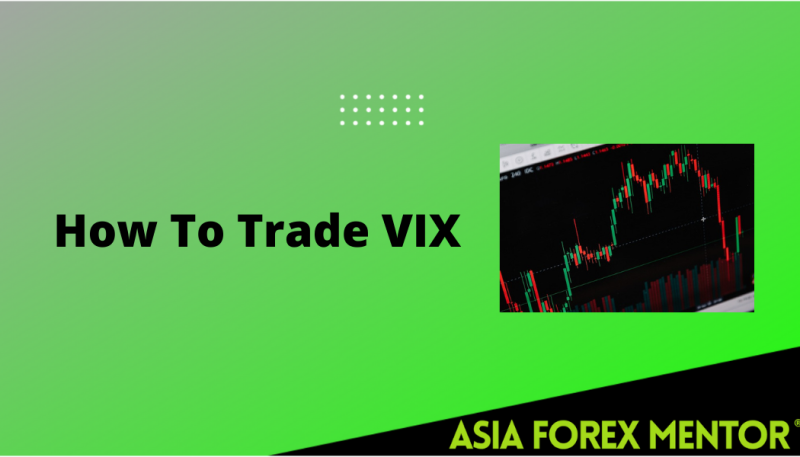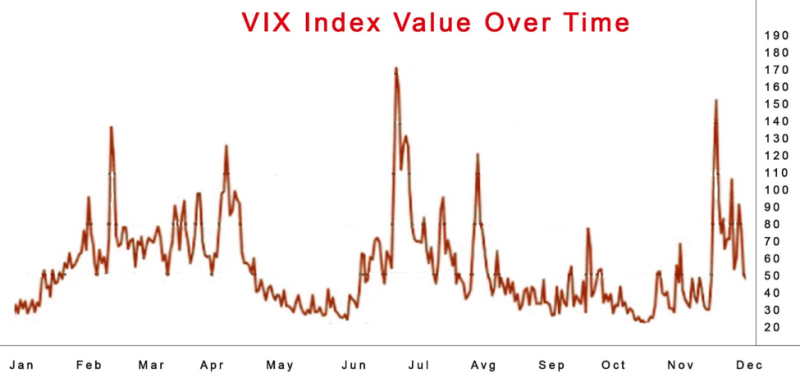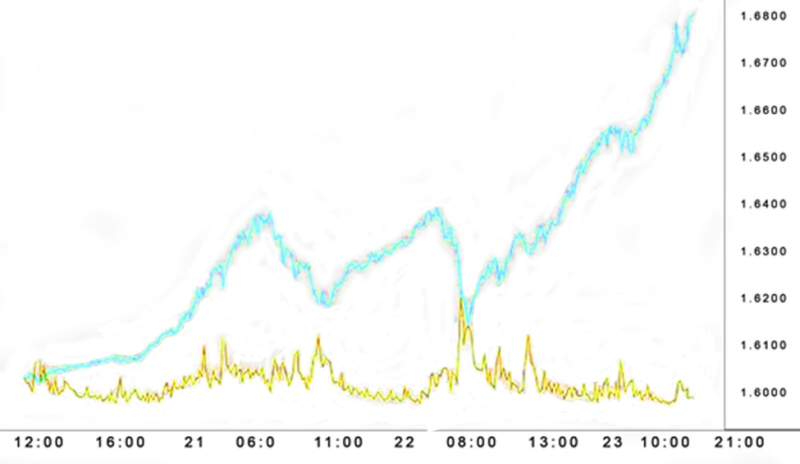
Markets are always in a state of flux, and traders’ decisions, economic and political news, earning reports also contribute to the frequent changes. An alternative way to word change is to label it as stock market volatility, a term familiar to traders. Some fear it, while others see it as an opportunity for profits from future volatility.

No matter to which philosophy you subscribe, learning and observing the CBOE volatility index is a priority for traders.
The moment an instrument got invented to identify and predict potential volatility, traders began to look for ways to trade more proficiently with the VIX Index.
The negative perception of volatility and its relationship to the stock prices have made traders interested in implementing volatility to hedge portfolios.
Also Read: Discover the Historical Volatility
Contents
- What Is the VIX?
- How Market Volatility Gets Measured
- How do You Calculate the VIX?
- Choosing to go Long or Short on the VIX
- Precisions When Trading the VIX Volatility Index
- Conclusion
- FAQs
What Is the VIX?
The VIX is complex to estimate, the primary aim is to calculate the number of volatility, traders predict to observe in the S&P 500 Index in the upcoming month, created on prices of S&P 500 Index options. It got formulated by the Chicago Board Options Exchange and is a yardstick for estimating volatility in the market.
If options traders expect the market to be stable, and the VIX to stay low, but when swings get expected, the VIX will move up.
In periods of intense market confusion, the VIX will climb. This usually happens when disruptive technologies emerge and interrupt the current business ecosystem.
Political crisis and financial problems in the banking sector will drive the VIX. It’s simple when market actors start panicking, and the reasons can be different, then the VIX will start rising.
Traders that observe the VIX performing a drastic rise when the market is declining that investors may be inclined to attempt investing in the VIX as an option for security in periods of market volatility.
Although the VIX estimates the S&P 500 volatility, it’s frequently implemented as a standard for the whole stock market. The price of options is perceived as a solid estimation of volatility when there is a reason for worry in the market, and market participants typically begin purchasing options in effect contributing to the rise in prices.
Because of this the VIX has acquired a reputation as a fear index and gets used as a tool to estimate stress levels in the market.
The present volatility is not apparent beforehand, and the VIX is more appropriate if implemented in combination with analysis of support and resistance lines.

How Market Volatility Gets Measured
There are two options to estimate volatility in the market. Method number one includes making statistical computations on previous prices in a given period. The method incorporates estimating different statistical figures such as standard deviation, variance, and average.
The generated estimate of standard deviation is an appraisal of volatility. Several software applications make it possible to estimate the stock price range. Still, the standard deviation is not the most precise option for estimating volatility because it’s a product of a method based on many presumptions.
Because it’s founded on previous prices, the final number gets named historical volatility. Forecasting volatility for an upcoming number of months gets based on estimating previous months and hoping the identical pattern will occur.
An alternative option is to calculate volatility by deducing the worth as suggested by options prices. Derivatives and options instruments that are related to the prospect of a given assets price are going far enough to achieve a given level, also known as the strike price.
Let’s take a hypothetical example, ABC stock is presently trading at $200 a share and with a call option on ABC with a strike price of $210 and a month until expiry. The price of the call option gets conditioned on the chances the ABC stock is going from the present level of $200, over the strike price of $210 in the month until expiration.
Because chances that type of price will go in a certain time frame gets showcased by the volatility, different option methods for pricing involve volatility as a crucial factor.
The options prices get offered in the market, they can get used to extract the volatility of the given asset. That type of volatility is lurking or assumed from prices in the market and is called implied volatility.
No method is accurate, with different advantages and disadvantages and various assumptions, but provides close results for volatility estimation in the close range.
How do You Calculate the VIX?
The VIX is estimated in real-time with active prices of S&P 500 options and incorporates basic CBOE SPX options that end on the 3rd Friday of the month but there are also weekly CBOE SPX options that end every Friday. For a VIX index, to get perceived as such is that the option should not expire between 23 and 37 days.
Basic estimation of the volatility includes highly intricate algebra, but it’s not required that investors learn the factors so they can transact with the index.
Still, the fundamental concept of the estimation means that by merging several call and put options in a broad specter of strike prices, investors will be aware of the prices and prepare to purchase and sell the.
They will get allowed for insertion and display the overall market impression about the strike prices that will get hit sooner than expiration. This signals the general sentiment of the market about the course of the price.
Choosing to go Long or Short on the VIX
Traders have two options when starting a position on the VIX, they can go long or short. It is crucial to know that volatility traders have no regard if the price of the S&P 500 will decline or climb, because of that investors can make a profit on both what they focus on is if the market is volatile.
Taking a Long Position on the VIX
The position a trader begins from gets conditioned on their predictions about volatility levels. Investors that deiced to go long are the ones that predict the volatility is going to rise, and appropriately the VIX also will go up.
When there are financial problems, and the market is experiencing turmoil, taking along position as an attractive option.
For example, when investors expect the S&P 500 to make a drastic fall after a political statement traders may initiate a long position, and this is done by starting a position by purchasing the VIX.
When there is volatility, the expectation will be precise, and investors will make a profit. Still, when starting a long position without the presents of volatility, the effect will be counterproductive resulting in losses.
Going Short on the VIX
In the case of starting a short position on the VIX, traders are predicting that the S&P 500 will gain in worth. Short-selling volatility is especially attractive if interest rates get reduced, and the economy is experiencing growth with minimal volatility in the financial markets.
For example, is the total of minimal volatility and serious economic progress have contributed to a stable increase in the S&P 500 share prices. Then investors can choose to short volatility in the hope that the market is going to continue it’s upwards trajectory and volatility is going to stay at reduced levels.
But in case the S&P 500 goes up, the VIX will probably go to a lower level, and investors can make a profit. Still, shorting volatility is not without risk, the possibility for significant loss is present when volatility climbs.
Also Read: How Do You Trade With A Volatility Indicator?
Precisions When Trading the VIX Volatility Index
When trading with something that’s named volatile, precautions are necessary to prevent losses. Let’s examine a few tips that can help in managing a trade of volatility index.
- Control the risk. Whit leveraged trading, investors can earn large profits, and at the same time incur significant losses. Traders will automate segments of the trade and control the risk by applying stop-loss and take-profit orders.
- Investigate and perform more research. Learn the ways an asset functions, what factors influence it, and gain an advantage in trading markets. In trading, knowledge also equals power, more information at an investor’s disposal, the bigger are the chances for success in meeting investment objectives.
Observe the implementation of leverage during trading ETFs, and know that leveraged ETFs are intricate financial tools with large risks, and only a few leveraged ETFs get perceived as adequate for veteran traders.

Conclusion
When the market is flooded with stress about potential economic turmoil then the high level of fear will replicate in the VIX index. If a lower VIX appears it will be a signal of investor smugness. By implementing the VIX with alternative methods for estimating volatility it can reveal serious elements with present investor sentiment.
It’s not possible to invest in VIX directly, and modern traders implement VIX ETFs to follow market volatility with a VIX futures contract.
The best investment advice for traders uses an investment strategy by making wagers on equity market volatility or using them as hedges, the VIX-related ETF and ETN products are appropriate but deficient tools. Still, they definitely offer ease of trading because they get invested similar to other assets.
It’s worth remembering that the volatility index is one model of volatility. Incorporating several methods and inputs in the trading strategy can offer to reduce risk if instead gambling on one variable?
VIX is a solid tool that investors can incorporate into their strategy. Experienced traders that focus on volatility trading can purchase and sell options. Still, traders can find out that the brokerage company they use will not permit them to sell options.
By purchasing VIX calls, spreads, or punts newbie traders have access to different volatility trades.
FAQs
Can You Trade VIX Directly?
The case with VIX is a similar situation with every index, meaning VIX cannot get purchased directly. The single option for traders to get VIX is with futures contracts and with exchange-traded funds and exchange-traded notes that possess VIX futures contracts.
How do You Trade with VIX?
The basic option to trade on VIX is to purchase ETFs and ETNs connected with VIX.
How Much do You Need to Trade VIX 75?
When trading VIX 75 attempt to stay away from ranging market, and search a supply zone on different times frame. It’s recommended to implement a risk management strategy, and if unsure about the market trend, then do not make trades.
How do You Buy VIX Calls?
Purchasing VIX call options provides a hedge against declines in the S&P 500 making it a good choice



